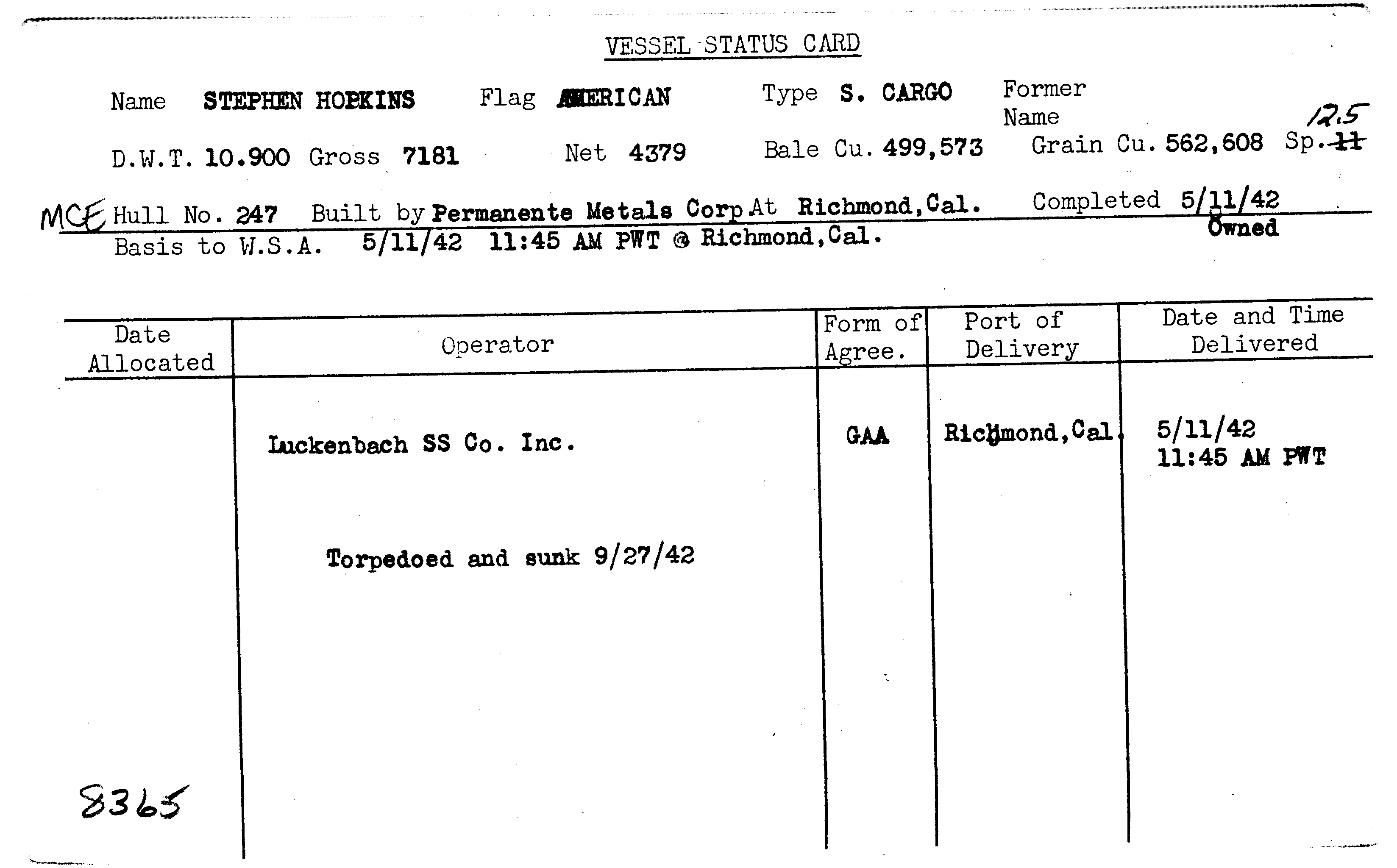STEPHEN HOPKINS

Historical Narrative
This Liberty ship was named
for Stephen Hopkins (1707-1785).
Stephen Hopkins was a Founding Father of the United States and politician.
Hopkins was a Rhode Island delegate to the Continental Congress and signed the
Declaration of Independence. Hopkins was elected to four terms as the governor
of the Colony of Rhode Island and Providence Plantations, serving from
1755-1757, 1758-1762, 1763-1765, and 1767-1768.
SS Stephen Hopkins was a Liberty ship, built by Permanente Metals Corporation at Richmond, California for the U.S. Maritime Commission and delivered on May 11, 1942. Placed immediately under the general agency of the Luckenbach Steamship Company, the vessel successfully completed a cargo mission to South Africa.
On September 19, 1942, Stephen Hopkins departed Cape Town, South Africa without cargo, planning to collect a load of bauxite from Surinam for transport to the United States. On September 27, the vessel unexpectantly sailed near the German commerce raider Stier (the vessel that sank the Gallant Ship recipient Stanvac Calcutta) meeting its resupply vessel, SS Tannenfels.
Because of the morning fog, the German vessels did not spot Stephen Hopkins until it came close by. They opened fire almost immediately, and one of the first shells to strike Stephen Hopkinsseverely injured LTJG Kenneth Willet, commander of the vessel’s Naval Armed Guard. Despite his injury, LTJG Willet took command of Stephen Hopkins‘s four-inch aft gun, which delivered several direct hits to Stier and Tannenfels.
As the two German ships closed in on Stephen Hopkins, the Liberty ship was able to use all of the weapons in its armament to fight back, but also suffered several crippling barrages, one of which destroyed the ship’s boilers and left it dead in the water. Another shell struck the aft ammunition magazine, throwing Willet, who was now the sole surviving member of the 4-inch gun crew, to the deck. Despite this, engine cadet-midshipman Edwin O’Hara managed to man the gun and fire off five more shells.
With Stephen Hopkins sinking, Captain Paul Buck gave orders to abandon ship. Willet and O’Hara were later killed by machine gun fire while attempting to release life rafts on the ship’s deck, but the crew was able to release a lifeboat and several rafts before Stephen Hopkins sank. Of the 46 crewmen, Armed Guard, and passengers on board, only 19 were able to make it to the lifeboat. The survivors of the Stephen Hopkins were able to construct a makeshift sail and drift toward Brazil; arriving at the village of Barro do Itabapoana on October 27, 1942. Of the original 19, there were 15 survivors.
Despite finally succumbing to the German raiders, Stephen Hopkins was able to critically damage Stier; it sank shortly after transferring its crew and prisoners to Tannenfels. That ship was also damaged, although it was able to return safely to Bordeaux, France.
In addition to Stephen Hopkins‘ recognition as a Gallant Ship, Captain Buck and cadet-midshipman O’Hara were posthumously awarded the Merchant Marine Distinguished Service Medal. LTJG Willet was posthumously awarded the Navy Cross.
Vessel Name History
Milestones
| No events for this vessel |
|---|
Ship Imagery
No images for this vessel
Status Cards

Plans
No documents for this vessel
Shipwreck Information
No ship wreck information for this vessel


